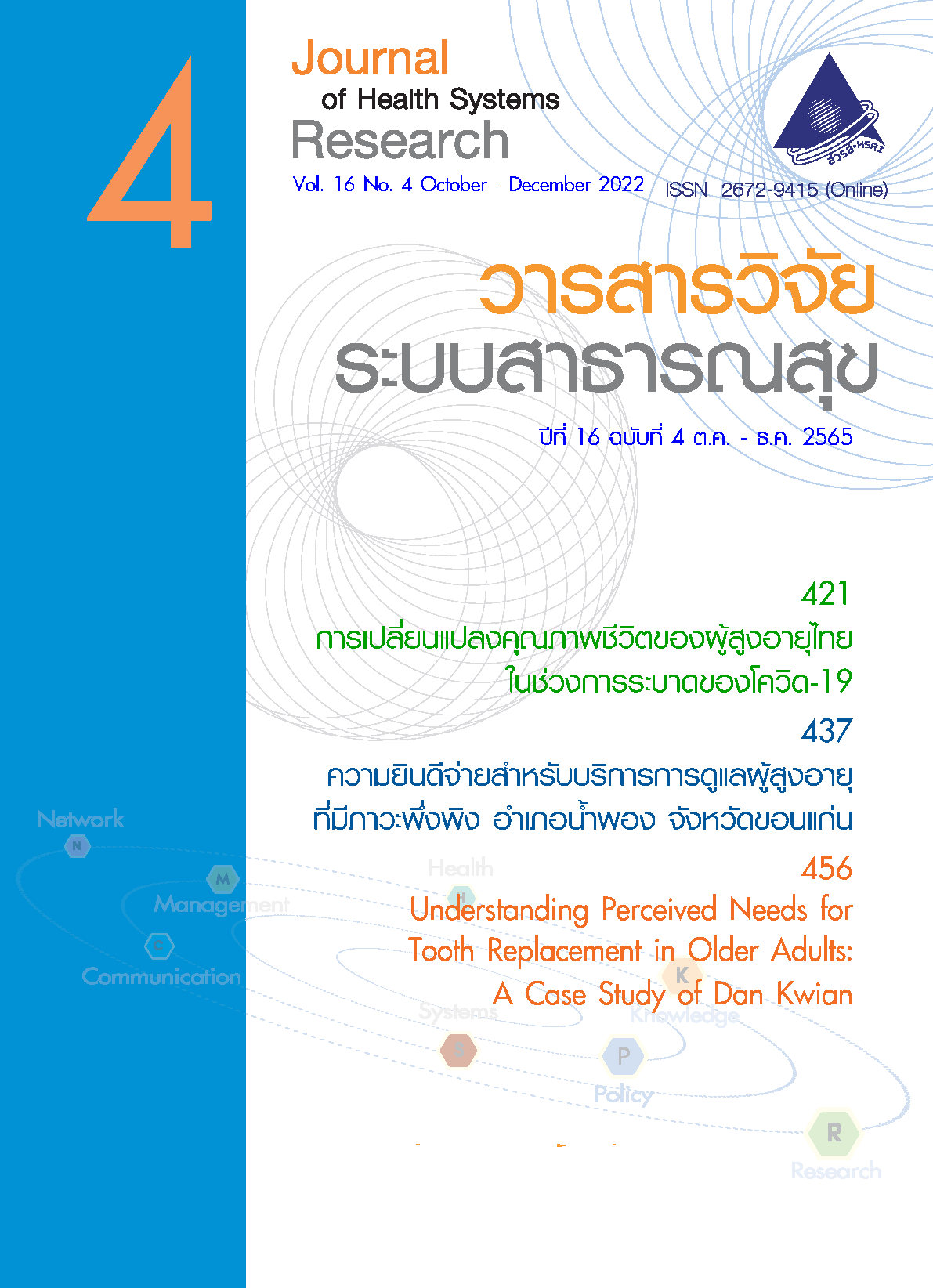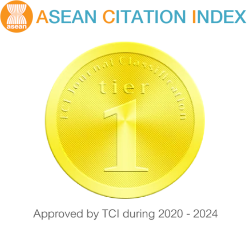การถ่ายทอดหลักฐานวิชาการกิจกรรมทางกายสู่นโยบายการสร้างเมืองที่กระฉับกระเฉง: การทบทวนวรรณกรรมแบบย่อ
คำสำคัญ:
กิจกรรมทางกาย, เมือง, ประสิทธิผล, นโยบาย, ประเทศไทยบทคัดย่อ
เป้าหมายการพัฒนาที่ยั่งยืนของสหประชาชาติ หมวดที่ 11 มุ่งมั่นให้เมืองและการตั้งถิ่นฐานของมนุษย์มีความครอบคลุม ปลอดภัย มีภูมิต้านทานและยั่งยืน เนื่องด้วยการขยายตัวของเมืองที่รวดเร็วส่งผลต่อการเพิ่มภาระโรคไม่ติดต่ออันเนื่องมาจากกิจกรรมทางกายไม่เพียงพอในประชากรเขตเมือง ทั้งนี้ ประเทศไทยยังขาดข้อมูลกิจกรรมทางกายของประชากรในเขตเมือง รวมถึงหลักฐานวิชาการด้านมาตรการส่งเสริมกิจกรรมทางกายในเขตเมือง การศึกษานี้มุ่งทบทวนหลักฐานวิชาการเกี่ยวกับกิจกรรมทางกายและมาตรการส่งเสริมกิจกรรมทางกายในเขตเมืองจากนานาชาติและในประเทศ และเสนอข้อเสนอเชิงนโยบายส่งเสริมกิจกรรมทางกายในเขตเมือง ผลการศึกษาพบว่าการส่งเสริมการเดินทางด้วยการเดิน การใช้จักรยาน และขนส่งสาธารณะ การออกแบบและพัฒนาเมืองโดยใช้สถานีขนส่งสาธารณะเป็นศูนย์กลาง และการสนับสนุนนันทนาการในทุกกลุ่มวัย เป็นนโยบายสำคัญในการจัดการปัญหาพฤติกรรมเนือยนิ่งในประเทศไทย
เอกสารอ้างอิง
United Nations. World urbanization prospects: the 2018 revision. New York: United Nations, Department of Economic and Social Affairs, Population Division; 2018.
World Health Organization. Promoting health in the SDGs. Geneva: World Health Organization; 2017.
Giles-Corti B, Lowe M, Arundel J. Achieving the SDGs: evaluating indicators to be used to benchmark and monitor progress towards creating healthy and sustainable cities. Health Policy. 2020;124(6):581-90.
Lee IM, Shiroma EJ, Lobelo F, Puska P, Blair SN, Katzmarzyk PT, et al. Effect of physical inactivity on major non-communicable diseases worldwide: an analysis of burden of disease and life expectancy. Lancet. 2012;380(9838):219-29.
World Health Organization. Global health risks: mortality and burden of disease attributable to selected major risks. Geneva: World Health Organization; 2009.
World Health Organization. 9th Global Conference on Health Promotion Shanghai 2016. Shanghai Consensus on Healthy Cities 2016 Shanghai: 9th Global Conference on Health Promotion Shanghai 2016; 2003 [cited 2021 Mar 23]. Available from: https://www.who.int/healthpromotion/conferences/9gchp/9gchp-mayors-consensus-healthy-cities.pdf?ua=1.
World Health Organization. Global action plan on physical activity 2018-2030. Geneva: World Health Organization; 2018.
World Health Organization. Global status report on noncommunicable diseases 2014. Geneva: World Health Organization; 2014.
Katewongsa P, Widyastaria DA, Saonuam P, Haematulin N, Wongsingha N. The effects of COVID-19 pandemic on physical activity of the Thai population: evidence from Thailand’s surveillance on physical activity 2020. J Sport Health Sci. 2021 May;10(3):341-8. doi: 10.1016/j.jshs.2020.10.001.
Thailand Physical Activity Knowledge Development Center. Regenerating physical activity in Thailand after COVID-19 pandemic. Nakorn pathom: Thailand Physical Activity Knowledge Development Center; 2020. (in Thai)
Liangruenrom N, Topothai T, Topothai C, Suriyawongpaisan W, Limwattananon S, Limwattananon C, et al. Do Thai people meet recommended physical activity level?: the 2015 national health and welfare survey. Journal of Health Systems Research. 2017;11(2):205-20. (in Thai)
Topothai T, Liangruenrom N, Topothai C, Suriyawongpaisan W, Limwattananon S, Limwattananon C, et al. How much of energy expenditure from physical activity and sedentary behavior of Thai adults: the 2015 national health and welfare survey. Journal of Health Systems Research. 2017;11(3):327-44. (in Thai)
Topothai T, Topothai C, Pongutta S, Suriyawongpaisan W, Chandrasiri O, Thammarangsi T. The daily energy expenditure of 4 domains of physical activity of Thai adults. Journal of Health Systems Research. 2015;9(2):168-80. (in Thai)
Tuangratananon T, Liangruenrom N, Topothai T, Topothai C, Limwattananon S, Limwattananon C, et al. Differences in physical activity levels between urban and rural adults in Thailand: findings from the 2015 national health and welfare survey. Journal of Health Systems Research. 2018;12(1):27-41. (in Thai)
Hallal PC, Andersen LB, Bull FC, Guthold R, Haskell W, Ekelund U, et al. Global physical activity levels: surveillance progress, pitfalls, and prospects. Lancet. 2012;380(9838):247-57.
Ng SW, Popkin BM. Time use and physical activity: a shift away from movement across the globe. Obes Rev. 2012;13(8):659-80.
Audrey S, Fisher H, Cooper A, Gaunt D, Metcalfe C, Garfield K, et al. Public health research. A workplace-based intervention to increase levels of daily physical activity: the Travel to Work cluster RCT. Southampton (UK): NIHR Journals Library; 2019.
National Statistical Office MoIaCT. Direction of population working 1990-2011. Bangkok: National Statistical Office, Ministry of Information and Communication Technology; 2012.
National Statistical Office MoIaCT. Situation of population working: October 2020. Bangkok: National Statistical Office, Ministry of Information and Communication Technology; 2020.
Division of Physical Activity and Health, Department of Health, Ministry of Public Health, Thailand. Recommendations on physical activity, non-sedentary lifestyles, and sleeping. Bangkok: NC Concept; 2017. (in Thai)
Topothai T, Piyathawornanan C, Asawutmangkul U. Lessons learnt from developing and implementing the National Steps Challenge in Thailand. Journal of Health Systems Research. 2020;14(4):478-88. (in Thai)
Topothai T, Suphanchaimat R, Tangcharoensathien V, Putthasri W, Sukaew T, Asawutmangkul U, et al. Daily step counts from the first Thailand National Steps Challenge in 2020: a cross-sectional study. Int J Environ Res Public Health. 2020;17(22):8433.
Office of Transport and Traffic Policy and Planning MoT. Railway Development and Long Term Plan in Thailand Bangkok: Office of Transport and Traffic Policy and Planning; 2017 [cited 2020 Nov 27]. Available from: http://www.otp.go.th/uploads/tiny_uploads/PDF/2560-11/25601124-Raiwal-DevOTP.pdf. (in Thai)
Gelius P, Messing S, Goodwin L, Schow D, Abu-Omar K. What are effective policies for promoting physical activity? A systematic review of reviews. Prev Med Rep. 2020;18:101095.
Gerike R, de Nazelle A, Nieuwenhuijsen M, Panis LI, Anaya E, Avila-Palencia I, et al. Physical Activity through Sustainable Transport Approaches (PASTA): a study protocol for a multicentre project. BMJ Open. 2016;6(1):e009924.
Kim EJ, Kim J, Kim H. Does environmental walkability matter? The role of walkable environment in active commuting. Int J Environ Res Public Health. 2020;17(4)1261. doi: 10.3390/ijerph17041261.
Kim EJ, Kim J, Kim H. Neighborhood walkability and active transportation: a correlation study in leisure and shopping purposes. Int J Environ Res Public Health. 2020;17(7):2178. doi: 10.3390/ijerph17072178.
Sallis JF, Cerin E, Conway TL, Adams MA, Frank LD, Pratt M, et al. Physical activity in relation to urban environments in 14 cities worldwide: a cross-sectional study. The Lancet. 2016;387(10034):2207-17.
Division of Physical Activity and Health, Department of Health, Ministry of Public Health. 12 Local authority models on physical activity promotion. Nonthaburi: Informan Teem Computer; 2018. (in Thai)
Division of Physical Activity and Health, Department of Health, Ministry of Public Health. Recommendation on physical activity promotion administration by local authorities. Nonthaburi: Informan Teem Computer; 2018. (in Thai)
Khamput T, Patsorn K, Thongbo T, Seunglee S, Keryai T, Sangsamritpol W, et al. Administration of physical activity promotion by twelve local administrative organizations in Thailand. Journal of Health Systems Research. 2019;13(1):63-89. (in Thai)
Sangsamritpol W, Samart P, Puangkrampun M, Seunglee S, Khamput T, Thongbo T, et al. Physical activity promotion for early childhoods in Thailand: a case study in five regions. Regional Health Promotion Center 7 Journal 2020;12(2):28-45. (in Thai)
Topothai T, Topothai C, Suphanchaimat R, Chandrasiri O, Sukaew T, Putthasri W, et al. The promotion of walking and biking for transportation, and public transport using: a case study in four communities in Thailand. Nonthaburi: International Health Policy Program; 2020.
Topothai T, Topothai C, Suphanchaimat R, Chandrasiri O, Sukaew T, Tangcharoensatien V, et al. Physical activity, carbon dioxide emission and cost of transport: a case study of three communities in Thailand. Journal of Health Systems Research. 2020;14(4):458-77. (in Thai)
Tuangratananon T, Topothai T, Khamput T, Saengruang N, Kosiyaporn H, Kulthanmanusorn A, et al. Public policy and social determinants of health management at three levels of municipalities in Thailand. Journal of Health Systems Research. 2018;12(3):384-403. (in Thai)
Division of Physical Activity and Health, Department of Health, Ministry of Public Health. Thailand Physical Activity Strategy 2018-2030 Bangkok: NC Concept; 2018. (in Thai)
Freak-Poli R, Cumpston M, Albarqouni L, Clemes SA, Peeters A. Workplace pedometer interventions for increasing physical activity. Cochrane Database Syst Rev. 2020;7:CD009209.
Ronghanam P. Walking behaviors of commuter who have switched to use the Bangkok Mass Transit System (BTS). Bangkok: Chulalongkorn University; 2013.
Giles-Corti B, Vernez-Moudon A, Reis R, Turrell G, Dannenberg AL, Badland H, et al. City planning and population health: a global challenge. The Lancet. 2016;388(10062):2912-24.
Gotschi T, de Nazelle A, Brand C, Gerike R, Consortium P. Towards a comprehensive conceptual framework of active travel behavior: a review and synthesis of published frameworks. Curr Environ Health Rep. 2017;4(3):286-95.
Institute for Transportation and Development Policy. Eight principles for better streets and better cities. New York: Institute for Transportation and Development Policy; 2020 [cited 2021 Mar 21]. Available from: https://www.itdp.org/what-we-do/eight-principles/.
Lu Y, Gou Z, Xiao Y, Sarkar C, Zacharias J. Do transit-oriented developments (TODs) and established urban neighborhoods have similar walking levels in Hong Kong? Int J Environ Res Public Health. 2018;15(3). doi: 10.3390/ijerph15030555.
Sreedhara M, Valentine Goins K, Frisard C, Rosal MC, Lemon SC. Stepping up active transportation in community health improvement plans: findings from a national probability survey of Local Health Departments. J Phys Act Health. 2019;16(9):772-9.
Thrun E, Leider J, Chriqui JF. Exploring the cross-sectional association between transit-oriented development zoning and active travel and transit usage in the United States, 2010-2014. Front Public Health. 2016;4:113. doi: 10.3389/fpubh.2016.00113.
ดาวน์โหลด
เผยแพร่แล้ว
รูปแบบการอ้างอิง
ฉบับ
ประเภทบทความ
สัญญาอนุญาต
ลิขสิทธิ์ (c) 2025 วารสารวิจัยระบบสาธารณสุข

อนุญาตภายใต้เงื่อนไข Creative Commons Attribution-NonCommercial-NoDerivatives 4.0 International License.
วารสารวิจัยระบบสาธารณสุขอยู่ภายใต้การอนุญาต Creative Commons Attribution-NonCommercial-NoDerivatives 4.0 International (CC BY-NC-ND 4.0) เว้นแต่จะระบุไว้เป็นอย่างอื่น



